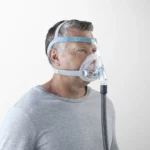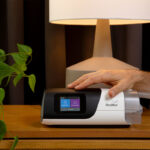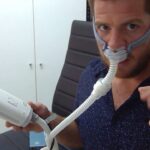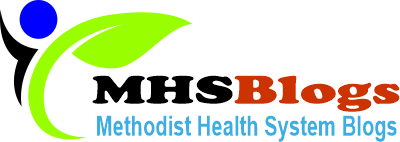What Does a High CPAP AHI Mean?

Users of continuous positive airway pressure (CPAP) devices and apps often report feeling confused by the data they are presented with. The AHI is one such, if not the most significant measures that your CPAP machine records. In this article, we’ll discuss how to evaluate your AHI and what steps you may take to bring it down if necessary.
In CPAP terms, what does an AHI mean?
Apnea-hypopnea index is the abbreviation for this measurement. Sleep studies are the gold standard for estimating AHI. The word REI (respiratory event index) may be used instead of AHI in a home sleep apnea test result.

When you remove your CPAP mask in the morning, many devices may display information about your use the night before, including your AHI. To differentiate this value from the AHI that is determined by the gold standard, a sleep study, I prefer to call it the “calculated AHI” or cAHI.
With the use of a CPAP machine’s smartphone app, you may collect and analyze more data over time. You need to connect your CPAP machines to a clinical database in order to get the full range of available information. The AHI is broken down into snoring, central apneas, obstructive apneas, and hypopneas, which I, as a sleep physician, can access.
CPAP: what’s a decent AHI?
In most cases, the cAHI should be set at or below 5, as this value indicates the absence of sleep apnea as determined by a sleep study. From what I’ve seen, a cAHI of 5 or less is considered good, but a cAHI of 3 or less indicates that your sleep apnea is under excellent control. Please be aware that I have never encountered a zero AHI. No matter how well you program your system, it will always estimate a small number of breathing occurrences as a residual.
“Treat the patient, not the numbers” is a common medical maxim. Nighttime oxygen level studies are frequently checked if an AHI is high despite the patient’s report of good sleep and general well-being during the day. I will not adjust the CPAP settings if oxygen levels are within normal range. You can read about CPAP and Bi-level PAP Therapy: New and Established Roles by clicking here.
Ways the CPAP machine reports the AHI
An AHI estimate is calculated by CPAP devices using proprietary algorithms. We sleep doctors think the gadget “pings” your airway with little bursts of air to test if it is open, measuring resistance to the airflow they are trying to provide.

For example, a CPAP machine will “ping” your airway if it detects a lack of airflow for more than 10 seconds. An obstructive apnea is detected if the air packet is reflected back to the monitor, indicating that the airway was blocked. If the air packet doesn’t come back, it indicates that your airway was clean and that this apnea was central. Hypopneas are thought to occur when there is a sudden and dramatic increase in resistance to the airflow given by the CPAP for at least 10 seconds.
Keep in mind that the cAHI should be viewed with caution because CPAP devices do not conduct diagnostic sleep studies on you on a nightly basis. Visit http://mhsblogs.com/guide-on-how-to-set-up-your-cpap-pressure-correctly/ to read about the Guide on How to Set Up Your CPAP Pressure Correctly.
Is the CPAP AHI reliably accurate?
Not at all true. Keep in mind that the cAHI can provide you a very accurate picture of how well you’re performing overall. Moreover, it is essential to examine the data patterns, rather than relying on a single night’s worth of information, before drawing any judgments. Mask seal, alcohol consumption, drugs, body posture, altitude, and other variables can all affect AHI from one night to the next. Before evaluating whether or not a CPAP machine has to be changed based on the cAHI, we want to gather at least two weeks of continuous data.
By and large, we have found that the AHI from a sleep study done on the same patient while they were using CPAP is much greater than the cAHI from the CPAP machine. The cAHI may be grossly underestimating the true incidence of residual abnormal breathing occurrences, as we believe it does.
The cAHI can give you a ballpark figure for how many residual abnormal breathing episodes you’re averaging each hour, but it shouldn’t be seen as gospel.
How can a CPAP’s AHI be reduced?
To put it simply, high leak is the most prevalent cause of a high cAHI. Your airway will continue to collapse if air is exiting from the system rather than entering your throat. When a leak occurs, it might be one of two types: the mouth leak and the mask leak.
The most prevalent sign of a leaking mouth is a persistently dry mouth when you wake up. Wearing a full-face mask or chin strap if you’re experiencing this is highly recommended.
If your CPAP mask is leaking, you need to replace it. Those who use CPAP and sleep on their side may also require a certain type of pillow.
Complex sleep apnea, in which you have obstructive sleep apnea before starting CPAP, can also lead to a high CPAP AHI.
With this issue, there may be a need for you to adjust the pressure in your machine. Among the many possible ways to this are:
The pressure reading from your machine may be inaccurate for you due to a number of reasons, including but not limited to: your body weight; some kind medical conditions that might exacerbate sleep apnea, such as hypothyroidism, PCOS, atrial fibrillation, heart attacks, and strokes; New drugs that can impact muscle tone or the diameter of your airway, such as testosterone;
If your AHIs have been consistently high and the cause does not appear to be a leak, you should consult a sleep specialist.
Users of continuous positive airway pressure (CPAP) devices and apps often report feeling confused by the data they are presented with. The AHI is one such, if not the most significant measures that your CPAP machine records. In this article, we’ll discuss how to evaluate your AHI and what steps you may take to bring…
Recent Posts
 CPAP Masks Australia: A Comprehensive Guide to the Best Options AvailableContinuous Positive Airway Pressure (CPAP) therapy is a common and effective treatment for obstructive sleep apnea. One crucial component of this therapy is the CPAP mask, which delivers the airflow necessary to keep the airways open during sleep. In […]
CPAP Masks Australia: A Comprehensive Guide to the Best Options AvailableContinuous Positive Airway Pressure (CPAP) therapy is a common and effective treatment for obstructive sleep apnea. One crucial component of this therapy is the CPAP mask, which delivers the airflow necessary to keep the airways open during sleep. In […] CPAP Mask Online Shopping: How to Ensure You’re Choosing the Right Mask for YouChoosing the right CPAP mask for your needs is essential for effective sleep apnea treatment. With the convenience of online shopping, it’s possible to find various options without stepping out of your home. However, the multitude of choices available […]
CPAP Mask Online Shopping: How to Ensure You’re Choosing the Right Mask for YouChoosing the right CPAP mask for your needs is essential for effective sleep apnea treatment. With the convenience of online shopping, it’s possible to find various options without stepping out of your home. However, the multitude of choices available […] Discovering Your Sleep Type: The Benefits of a Sleep Type TestDo you often find yourself tossing and turning at night, struggling to fall asleep? Or maybe you drift off to dreamland effortlessly but still wake up feeling groggy and exhausted. If either of these scenarios sounds familiar, it’s possible that […]
Discovering Your Sleep Type: The Benefits of a Sleep Type TestDo you often find yourself tossing and turning at night, struggling to fall asleep? Or maybe you drift off to dreamland effortlessly but still wake up feeling groggy and exhausted. If either of these scenarios sounds familiar, it’s possible that […] Sleep Apnea Testing in Brisbane: Your Complete GuideSleep apnea is a common sleep disorder that affects many people in Brisbane and around the world. If left untreated, it can lead to serious health complications. In this complete guide, we will explore everything you need to know about sleep apnea […]
Sleep Apnea Testing in Brisbane: Your Complete GuideSleep apnea is a common sleep disorder that affects many people in Brisbane and around the world. If left untreated, it can lead to serious health complications. In this complete guide, we will explore everything you need to know about sleep apnea […] Sleep Study Ipswich: Analysing Sleep Patterns in QueenslandSleep is a fundamental aspect of our daily lives, yet it is often overlooked and undervalued. In recent years, sleep disorders have been on the rise, leading to a growing concern for public health. To shed light on this issue, a comprehensive sleep study […]
Sleep Study Ipswich: Analysing Sleep Patterns in QueenslandSleep is a fundamental aspect of our daily lives, yet it is often overlooked and undervalued. In recent years, sleep disorders have been on the rise, leading to a growing concern for public health. To shed light on this issue, a comprehensive sleep study […] Sleep Study Referral: Understanding the Process and RequirementsIn today’s fast-paced world, getting a good night’s sleep has become increasingly difficult for many individuals. From hectic work schedules to the constant distractions of technology, it’s no wonder that sleep disorders are on the […]
Sleep Study Referral: Understanding the Process and RequirementsIn today’s fast-paced world, getting a good night’s sleep has become increasingly difficult for many individuals. From hectic work schedules to the constant distractions of technology, it’s no wonder that sleep disorders are on the […] ResMed AirMini vs Traditional CPAP Machines: A Comparative AnalysisIn the world of sleep apnea treatment, Continuous Positive Airway Pressure (CPAP) therapy has proven to be highly effective in improving the quality of sleep for patients. CPAP machines work by providing a constant flow of air to keep the airways open […]
ResMed AirMini vs Traditional CPAP Machines: A Comparative AnalysisIn the world of sleep apnea treatment, Continuous Positive Airway Pressure (CPAP) therapy has proven to be highly effective in improving the quality of sleep for patients. CPAP machines work by providing a constant flow of air to keep the airways open […] Tips for Optimizing Your Experience with the ResMed AirMiniThe ResMed AirMini is a compact and convenient device that offers a host of features to enhance your sleep experience. Whether you are new to using this device or looking for ways to improve your current setup, this article will provide you with valuable […]
Tips for Optimizing Your Experience with the ResMed AirMiniThe ResMed AirMini is a compact and convenient device that offers a host of features to enhance your sleep experience. Whether you are new to using this device or looking for ways to improve your current setup, this article will provide you with valuable […] Eye Surgery, LASIK vs Contact Lenses: Which One Should You Choose?Eye surgery, LASIK, or laser vision correction. The procedure goes by many names, but regardless of what you call it, LASIK surgery is one of the most popular permanent options for those with poor vision. But while laser eye surgery works for various […]
Eye Surgery, LASIK vs Contact Lenses: Which One Should You Choose?Eye surgery, LASIK, or laser vision correction. The procedure goes by many names, but regardless of what you call it, LASIK surgery is one of the most popular permanent options for those with poor vision. But while laser eye surgery works for various […]![Is Laser Eye Surgery Worth the Cost? [Complete Guide]](https://mhsblogs.com/wp-content/uploads/2023/05/LASIK-SMILE-and-PRK2-150x150.jpg) Is Laser Eye Surgery Worth the Cost? [Complete Guide]You may be considering going for laser eye surgery soon. The entire laser eye surgery procedure is quick and painless and eliminates the need for glasses or contact lenses for a very long time. However, laser vision correction can also be expensive. […]
Is Laser Eye Surgery Worth the Cost? [Complete Guide]You may be considering going for laser eye surgery soon. The entire laser eye surgery procedure is quick and painless and eliminates the need for glasses or contact lenses for a very long time. However, laser vision correction can also be expensive. […]
